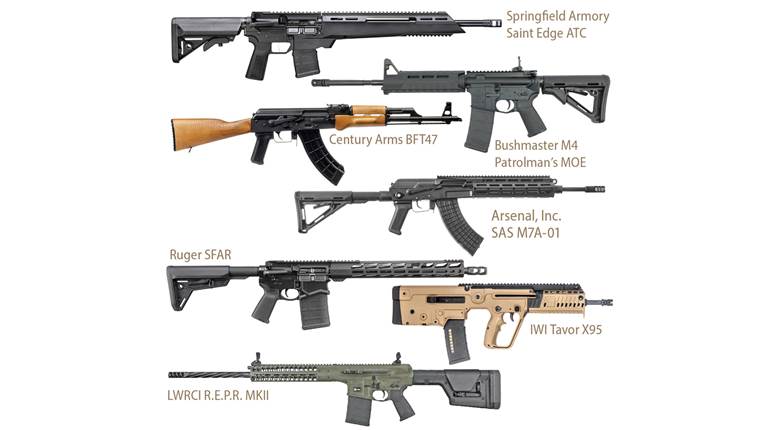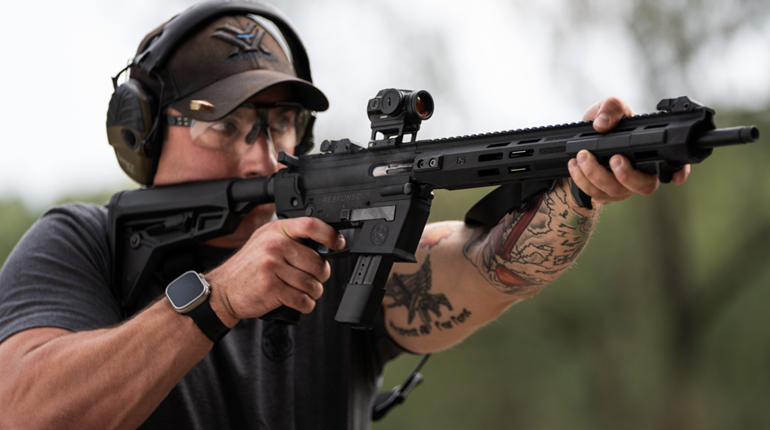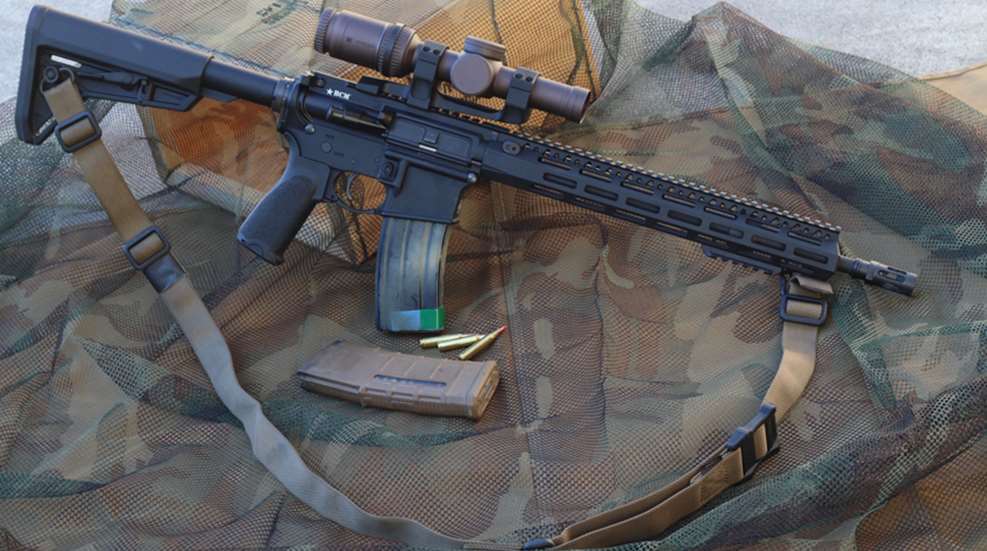
The AR market is certainly mature. There are rifles at every price point imaginable and with a wide expanse of features. I was just beginning to think that the platform was beyond major refinement, coming down to minor changes that had more to do with a shooter’s particular usage or preference than anything else. Over the past six months I’ve been shooting the new Bravo Company Mfg (BCM) Mk 2 Upper Receiver and rather quickly realized that the basic AR platform still had space for improvement. BCM just planted its star logo flag in it.
There is a lot going on with the Mk2 upper, and most of it will escape casual scrutiny unless pointed out. Most significant is a redistribution of the mass and structure of the receiver to reinforce its rigidity at the barrel. While BCM was remaking the forging, they moved the forward assist to a more convenient location. To accommodate shooters using suppressors, they then looked at gas movement in the charging handle track and added an expansion area and redirecting vents. And they did all of this while maintaining weight; the Mk2 is within fractions of an ounce of a standard flattop receiver.
BCM believed that as good as the optic-ready flattop AR was, the system lost significant structural integrity with the removal of the forged-in carry handle that had been a part of the original design. The rigidity of the flattop AR series has been a longstanding issue among users of high-end ARs. Optics and the free-floated rails that became popular in the last decade unlocked the accuracy potential of the system. However, as shooters became accustomed to 1.5 MOA or better accuracy out of quality carbines, that same precision highlighted something else: zero shift. The typical flattop AR can be susceptible to zero shift as pressure to the handguards is changed, even with a free floated rail. For example, the point of impact when shooting from prone with forward pressure onto bipod legs can be different than when pressing the rail into the side of a barricade for support. There simply isn’t enough rigidity in the receiver to resist the leverage of forces applied out at different places on the rails. The ejection port is a large, mostly unreinforced hole, which BCM believed was the weak link. 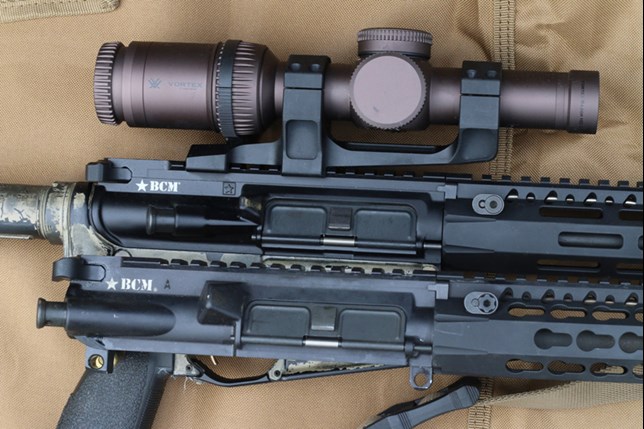
BCM Mk2 (top) showing the reinforcement around the ejection port as well as the combination of the forward assist and shell deflector into a single protrusion.
In some rifles the shift can be mild enough to go unnoticed, but in others it can be an issue. A while back, a good friend (a federal law enforcement sniper), was discussing this with me. He had been shooting one of the most expensive, high-end ARs on the market and was very pleased with its MOA accuracy, but frustrated by the shift he was seeing in different shooting positions/supports. He asked me what I thought, and I sympathized, saying that it seemed to be just part of the landscape with current rifles. I mentioned that I tried to keep data on my favorite rifles to know where I might expect a slight offset due to support and force direction.
The resistance to zero shift was one of the first things I noticed with the BCM Mk2. There was almost no difference when shooting from bipod, monopodding off of the magazine, leaning into barricades at different angles, or with tightened slings. I was noticing this before I even had BCM’s press materials with the features spelled out; the upper had arrived with no documentation, and I simply started shooting it. Once the press kit listed all of the features, it was nice converging validity with my shooting data.
The Mk2 upper receiver moves mass into thoughtful reinforcement of the front of the receiver, and the ejection port in particular. It isn’t visually obvious at a glance, but the instant your left hand curls around the receiver to close the ejection port cover, your fingers feel a distinct difference in the shape and mass around the ejection port itself. After decades of closing essentially identical mil spec ejection port covers, it was a bit of a surprise to feel such a shelf around the port. BCM estimates that there is about 60 percent more mass reinforcing the forward end of the receiver.
Bravo Company estimates that the effect of its redesigned forging is 30 percent more rigidity. In theory, that rigidity should be favorable to accuracy as well as resisting shift. I tested a variety of loads from the Mk2, shooting prone with Armageddon Gear bags supporting both the front and rear of the rifle. The upper sported a Vortex Razor HD Gen II E 1-6x optic. Group after group bracketed just a bit over 3/4 MOA, with a few having a fifth shot that stretched out toward one inch, and a couple that cut close to a half inch.
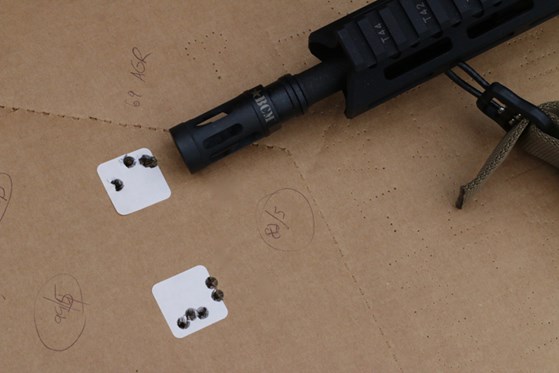
Five=shot groups from rested prone at 100 yards with Hornady and Black Hills loads.
For some of the groups I used a one-inch white paster as the aiming point, just able to center the cross hair and barely see four quadrants of white at six power. Several of the groups fit neatly within the paster. In others where a shot or two strayed off, I suspect it was likely my execution of the shot in question. I’ve fired many duty-weight ARs that would group under MOA with good ammo. However, this is the first lightweight, duty-style AR I’ve fired that was consistent enough in its exact point of impact group to group where one could almost expect to put five shots into a paster.
The accuracy testing was done with a lower receiver that has been my workhorse for nearly a decade, a high round count Noveske VTAC (now discontinued). As my testing progressed, I picked up a BCM lower receiver and installed a Wilson Combat M2 Tactical Trigger Unit. I thought it would be good to see the Mk2’s results on another lower and only appropriate to make that one a BCM as well. Shooting the Black Hills 60-gr. VMAXs that had averaged .79" earlier, the new combo put the shots to the identical point of impact and the groups punched into tight little clusters at .71", .75", .79", .90", and .92". The Wilson TTU broke at 4 lbs., with 2 lbs. of short take-up and then a nice crisp 2-lb. release. 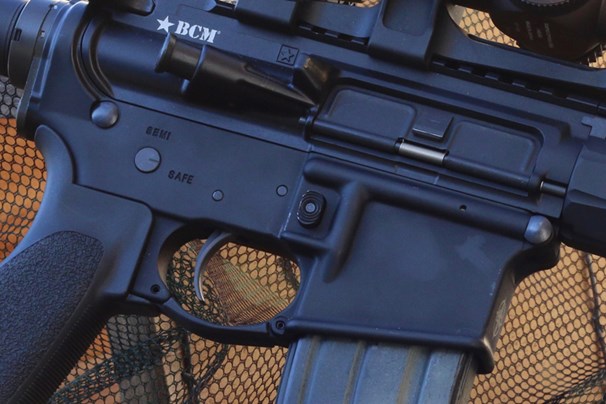
Wilson Combat Tactical Trigger Unit was simple to install and provided a light, crisp release suitable for multiple roles.
The Mk2 upper was outfitted with BCM’s Extreme Lightweight fluted and tapered barrel, perhaps busting some shooters’ expectations about lightweight barrels. During testing I don’t think I ever let the 14.5” barrel fully cool, simply shooting five shots and walking down to mark/measure then repeating the cycle.
Load Small Large Average
Black Hills 60-gr. VMAX .59 .99 .79
Federal 69-gr. Gold Medal .65 1.31 .91
Hornady 55-gr. American Gunner .69 1.01 .83
(BCM lower)
Black Hills 60-gr. VMAX .71 .92 .81
Five, five-shot groups fired at 100 yards
The Enhanced Lightweight (ELW) fluted barrel has been among my favorites since its introduction a few years ago. Its tapered design seems to offer consistent accuracy and resists overheating and stringing groups the way a traditional pencil barrel might. The feature I most enjoy is the resulting carbine weight and balance. Coupled with a lightweight handguard a carbine with the ELW barrel seems to hang just right for me and snaps to shoulder or target with a liveliness that is unexpected. Even outfitted with an optic and flashlight the overall system weight remains balanced and spry.
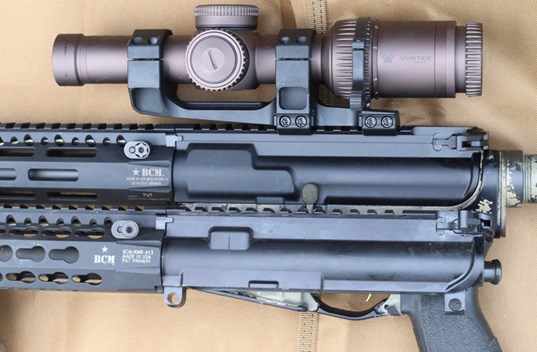
Mk2 (top) showing the reinforcement on the left side of the receiver compared to a standard M4 style receiver (bottom).
When BCM redesigned the forging for the Mk2, they also moved the forward assist and the cartridge deflector from two separate protrusions into a single unit. This was done primarily to borrow mass and redirect it forward, but the end result has its own benefit. The forward assist is now further forward in a more trim housing maintaining the traditional GI assist inside. This places the assist, which is used rather infrequently by most shooters, out of the way. Whether ambidextrous charging handle latches, optic power throw levers, or sling swivels mounted to the receiver end plate, the traditional forward assist location can be "in the way." The new location of the Mk2 clears this space nicely. This was most obvious to me when switching from the Mk2 to other uppers and then working ambidextrous charging handles.
I did not shoot the Mk2 suppressed, so I can’t speak to the built-in gas expansion area in the charging handle track. However, if this feature works as advertised, it should reduce a common complaint with the AR system. For years shooters have caulked their charging handles with silicone and tried other adaptations to reduce the amount of gas escaping the rear of the rifle when shooting suppressed.
BCM suggests that the increased structural integrity and resulting rigidity of their Mk2 should improve alignment as the bolt reciprocates and locks/unlocks, potentially decreasing battering and extending service life. If this turns out to be the case it will be a welcome plus for those with short barreled rifles, overgased, or suppressed rifles; each of which can have shorter relative life cycles before shearing bolt lugs.
The net effect of the BCM Mk2’s improvements is quite positive. No downside jumps out yet other than the decision and cost to replace. Whether the upsides are so significant as to upgrade from a current upper receiver is a question of the shooter's priorities and needs. Most may be in a position with a current carbine that is working well and may simply make a mental footnote to check out the new BCM should an occasion arise for a new upper or build. One of the more surprising aspects of BCM’s development is that the cost of the new Mk2 is currently listed at only $10 more than its standard receiver.
In the past when BCM has launched an AR related improvement, it has often spurred further development across the industry. There are some patents pending on the Mk2 but I suspect that the new upper will cause competitors and many shooters to take a fresh look at the AR platform, which is good for all of us.












